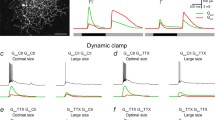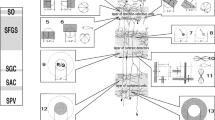Abstract
The ability to transmit signals in the retina in the absence of impulses was tested by means of two agents (tetrodotoxin and procain) blocking the impulse transmission of stimuli. The slow potential (SP) and impulse discharge were recorded simultaneously from the optic nerve of the frog. Tetrodotoxin (0.5 µg/cm3) and procain (0.5–1%) introduced into the eye cup completely blocked impulses but had little effect on SP. Therefore, signals from the photoreceptors to the ganglionic cells can be transmitted in the absence of impulses. These data confirm also a conclusion drawn earlier that the SP originates as a result of electrotonic spread of the postsynaptic potentials (PSP) of ganglionic cells along the optic nerve. The agents blocking the impulse transmission of stimuli broke down the lateral inhibition between the "slow bipolars." Consequently, lateral inhibition spreads by means of the impulse mechanism in the transmission of signals. It is supposed that the interneurons participating in this spread are amacrine cells which possess the ability to generate impulses.
Similar content being viewed by others
Literature cited
A. L. Byzov, "The source of impulses recorded from the inner layers of the frog retina," Biofizika,4, 414–422 (1959).
A. L. Byzov, "Analysis of distribution of potentials and currents in bipolars," Biofizika,4, 689–701 (1959).
A. L. Byzov, Electrophysiological Investigations of the Retina [in Russian], Nauka, Moscow (1966).
A. L. Byzov and R. Khanich, "Intracellular recording of the reaction of various retina cells of the frog and the axolotl" Fiziol. Zh. SSSR,52, 250–257 (1964).
G. M. Zenkin, "Horizontal interaction of the level of bipolar cells of the frog retina," Biofizika,10, 1055–1062 (1965).
G. M. Zenkin and V. V. Maksimov, "Investigation of horizontal interaction on the level of slow bipolars of the frog retina. II. Quantitative interaction characteristics," Biofizika,9, 718–725 (1964).
G. M. Zenkin, V. V. Maksimov, and A. L. Byzov, "Investigation of horizontal interaction of the level of slow bipolars of the frog retina. 1. Influence of scattered light and some interaction properties," Biofizika,9, 612–620 (1964).
D. Letvin, Kh. Maturana, U. Pits, and U. Makkallokh, "Two notes on the optic system of the frog," in: Theory of Bond in Sensor Systems [in Russian], IL, Moscow (1964), pp. 416–432.
B. I. Khodorov, Excitation Problem [in Russian], Meditsina, Moscow (1969).
A. L. Byzov, "Functional properties of different cells in the retina of cold-blooded vertebrates," Cold Spring Harbor Symp. Quant. Biol.,30, 547–558 (1965).
J. E. Dowling, "Synaptic organization of the frog retina: an electron-microscopic analysis comparing the retinas of frog and primates," Proc. Roy. Soc.,170, 205–228 (1968).
A. Kaneko and H. Hashimoto, "Localization of spike-producing cells in the frog retina," Vision Res.,8, 259–262 (1968).
A. Kaneko and H. Hashimoto, "Electrophysiological study of single neurons in the inner nuclear layer of the cap retina," Vision Res.,9, 37–55 (1969).
B. Katz and R. Miledy, "Tetrodotoxin-resistant electrical activity in presynaptic terminals," J. Physiol. (Engl.),203, 459–487 (1969).
E. F. MacNichol and G. Svaetichin, "Electrical-responses from the isolated retinas of fishes", Amer. J. Ophthalmol.,46, Pt. 2, 26–40 (1958).
M. Murakami and Y. Shigematsu, "Quality of conduction mechanism in bipolar cells of the frog retina," Vision Res.,10, 1–10 (1970).
Ramon y Cajal, Die Retina der Wirbelthiere, Wiesbaden (1894).
G. Svaetichin, "The cone action potential," Acta Physiol. Scand.,29, Suppl., 106, 565–580 (1953).
M. Takashi, "Analysis of sodium and potassium conductance in the procain end-plate potential," J. Physiol. (Engl.),183, 592–606 (1966).
T. Tomita, "Electrical activity in the vertebrate retina," J. Opt. Soc. Amer.,53, 49–56 (1963).
T. Tomita, "Electrophysiological study of the mechanisms subserving color coding in the fish retina," Cold Spring Harbor Sympt. Quant. Biol.,30, 559–566 (1965).
F. S. Werblin and J. E. Dowling, "Organization of the retina of the mud puppy,Necturus maculosus, 2. Intracellular recording," J. Neurophysiol.,32, 339–355 (1969).
Additional information
Institute of Problems of Information Transmission, Academy of Sciences of the USSR, Moscow. Translated from Neirofiziologiya, Vol. 2, No. 5, pp. 536–543, September–October, 1970.
Rights and permissions
About this article
Cite this article
Byzov, A.L., Polishchuk, N.A. & Zenkin, G.M. On the transmission of signals in vertebrate retina in the presence and absence of impulses. Neurophysiology 2, 404–410 (1970). https://doi.org/10.1007/BF01062807
Received:
Issue Date:
DOI: https://doi.org/10.1007/BF01062807




